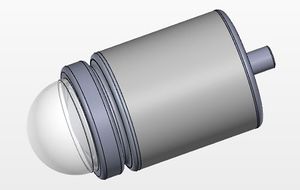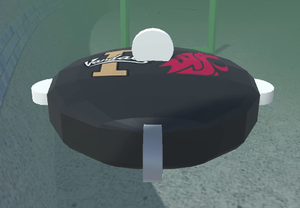NAVSEA Robosub Competition (2015-2016)
| Our Sponsors | Department of Mechanical Engineering
Department of Computer ScienceDepartment of Electrical Engineering Association for Unmanned Vehicle Systems Naval Sea Systems Command (NAVSEA) Office of Naval Research Robosub Club of the Palouse |
| Team Name | Tactical Underwater Nautilus Aquistition (T.U.N.A.) |
| Time Period | Fall 2015 - Summer 2016 |
The AVUSI sponsors an annual competition for autonomous robotic submarines (Robosubs). The competition is hosted in San Diego, CA, and challenges engineering skills across multiple disciplines. The competition team brings together engineers from across the Palouse, but this page highlights the efforts of the University of Idaho Capstone Design team.
Problem Definition[edit | edit source]
The main goal for the year is to design and produce a working, autonomous submarine capable of completing specified goals and tasks while meeting club/competition requirements.
Background[edit | edit source]
Launched in 1997 and co-sponsored by the Association for Unmanned Vehicle Systems International (AUVSI) and the Office of Naval Research (ONR), Robosub aimed to advance development of Autonomous Underwater Vehicles (AUVs) by challenging new generations of engineers to perform realistic missions in an underwater environment. The competition is open to high school and college teams from around the world and is held each year at the U.S. Navy Space and Naval Warfare Systems Center Pacific's TRANSDEC Anechoic pool in San Diego, CA.
Design Objectives[edit | edit source]
The Autonomous Submarine must be able to complete numerous tasks designated by the competition.
These tasks include:
- Move through a starting gate
- Navigating from task to task on a course using visual and audio cues
- Dropping markers at specified locations
- Accurately deploying torpedoes at targets
- Locate pinger and surface in appropriate area (typically an octagon)
How well each task is completed goes towards the overall team score for the competition. Other scoring can be attributed to subjective scoring.
These tasks include:
- Team Website
- Technical merit (Journal)
- Written Style (Journal)
- Tech accomplishments
- Craftsmanship
- Team Uniform
- Team Video
- Discretionary Static Points
Specifications[edit | edit source]
| General Requirements | Specific Requirements | Marginal Targets | Ideal Targets |
|---|---|---|---|
| Maneuverable | Control in the X,Y,Z directions | Ability to travel in these directions at a rate of .25 ft/s | Ability to travel in these directions at a rate of .5 ft/s |
| Control over yaw | 360° Rotation in under 8 seconds | 360° Rotation in under 6 seconds | |
| Control over roll and pitch | Stabilization within 3 seconds | Stabalization within 1 seconds | |
| Stable | Statically Stable | Center of mass bellow center of buoyancy | Center of mass bellow center of buoyancy/balanced across centerlines |
| Dynamically Stable | Ability to travel 5 ft with minor corrections | Ability to travel 15 ft with no corrections | |
| Positively Buoyant | Buoyant by at least .5% of mass | Buoyant by exactly .5% of mass | |
| Reliable | Watertight housings | Watertight up to 40 ft depths | Watertight up to 60 ft depths |
| Electronics remain cool | Continuous operation time of 45 min | Continuous operation time 1.5 hours | |
| Small size and Low Weight | Small outer dimensions | 8' x 5' x 5' | Less than 8' x 5' x 5' |
| Low weight in air | Less than 100lb | Less than 50lb | |
| Easy to work on | Modular components | Sub systems can be separated | All main systems can be separated |
| Replacement Parts | Main components can be replaced in 20 min | Main/minor components can be replaced in 15 min | |
| Easy to transport and store | Easily carried by two people | Easily carried by two people with a special container and stand | |
| Accurate Peripherals | Accurate Torpedo Launchers | Torpedoes accurate on 10" target from a distance of 2 ft | Torpedoes accurate on 7" target from a distance of 2 ft |
| Consistent PVC grabber | Grasps and Releases PVC structure consistently | Grasps and Releases PVC structure with ease | |
| Safe | Low open circuit voltage | Less than 60VDC | Less than 50VDC |
| Easy-to-Operate kill switches | Clearly marked and readily activated | Clearly marked and readily activated with protection against accidental operation | |
| Responsive | Keyboard input operates the thrusters | All thrusters are controlled by keyboard | Completely Autonomous |
Project Learning[edit | edit source]
Organized by Team
Camera Waterproofing
The cameras selected by the other teams will be mounted to the sub and waterproofed by the mechanical engineering team. They will need to be mounted such that they will perform as required for the competition, but do not interfere with other devices.
Overall mission is to make the camera housing completely water proof, using a fish lens for versatility. Mounting will be designed accordingly to work with the case
Battery Housing Efficient Battery Exchange
Create waterproof carrying tube for the sub’s battery which allows for efficient swapping during testing.
Power Housing O-Ring Face Seal
Create a new environment for the power control of the sub to reside free of water. Using an O-ring face seal, wing nut (hand controlled) pressure, and a experimental rectangular design, a housing with 24 "penetrator" bolts is able to supply power connection to the rest of the AUV without being in the main hull. Turns out that acrylic is not a good material to face seal with.
Buoyancy Approximations
Without the entire AUV assembled it is impossible to know whether or not our allowances for buoyancy were valid. All of our designs were pool tested for buoyancy and all proved buoyant besides the battery housing (near neutral). In the end the goal is to confirm the new volume of the submarine to determine 0.5% of total mass and buoyancy. This is important because the competition rules states that “All vehicles must be buoyant by at least one half of one percent (0.5%) of their mass when they have been shut off through the kill switch.”
Sub Simulation
Expansions will be made to the sub simulation software to allow it to interface with the sub AI, movement and vision software as a stand-in for the submarine. This will allow it to be used for easy testing of changes made to these systems.






